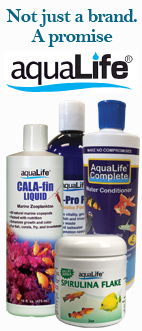|
|
Product Detail
|
|
|
 |
| Item#: |
SC3518 |
|
|
|

| Type Use: |
|
| Units/Case: |
1 |
| Wt Each: |
3.00 |
|
|

|
|
|
 |
|
|
|
|
|
| Product Name: |
Matrix Carbon 1L
|
|
| Category: |
Filter & Reactor Media* |
|
| Subcategory: |
Carbon |
|
| Manufacturer: |
Seachem |
|
|
|
|
Matrix Carbon is a truly unique activated carbon. It is formed as a spherical bead for optimum hydrodynamics and will not pack. It permits maximum water flow and contact with its high density of macroporous binding sites. Matrix Carbon has a very low ash content as indicated by its minimal impact on pH. Even when added to distilled water, it does not raise pH above 7.0. While all carbons contain phosphate, regardless of false claims to the contrary, Matrix Carbon has the lowest detectable, leachable phosphate content of all major carbon brands tested. Matrix Carbon outperforms other high grade carbons by at least two-fold when compared for total capacity to remove aquarium organic matter, rate of adsorption, and duration of use. This product is sold by volume. Cited weight is minimal weight.
DIRECTIONS: 250 mL will easily treat 400 L (100 gallons*) for several months. Matrix Carbon is very clean and nearly dust free. For best results, Matrix Carbon should be placed so as to maximize the flow of water through it. It may be used in a canister filter, chemical filtration module, box filter, or any high flow area of a trickle filter.
FAQ from Seachem
Q: How long does your Matrix Carbon last?
A: Matrix Carbon is the only spherical shaped carbon on the market. It will not compact and create dead zones due to restricted water flow, and consequently will use up all available absorptive sites before exhaustion. Actual time depends on initial water conditions. In very dirty water, it may last as little as a few hours; in very clean water it may last several months. In general, 3 - 6 months is typical.
Q: You claim Matrix Carbon's spiracle shape makes it a better carbon. Why does shape matter?
A: A spherical pellet has ideal hydrodynamic properties and provides for maximum water flow and contact without the compacting and channeling characteristic of granular activated carbon. Water channeling is likewise characteristic of carbon pelletized as cylindrical pellets. Such cylindrical pellets were originally engineered for air filtration and have poor water hydrodynamics. Matrix Carbon also has minimal impact on trace elements, an added bonus for the planted aquarium.
Compacting
Compacting occurs over time as the flat edges of granular carbon become situated against each other. Over time, the carbon becomes so tightly packed together that water flow is impeded. When this happens, the water to carbon contact is minimized.
Channeling
Where the problem with granular carbon is being packed too tightly, the problem with cylindrical pellets is not being packed tightly enough. As a result, channeling occurs. Water moves to easily through the channels between the carbon minimizing contact with absorptive sites.
Optimal Hydrodynamics
Matrix Carbon solves both compacting and channeling. Because of its unique spherical shape, Matrix Carbon provides maximum water flow and contact with a high density of adsorptive sites without the compacting of granular activated carbon.
Q: Recently I used Cupramine in my tank. Can I use the Matrix Carbon to remove the Cupramine.
A: Yes, since Cupramine is bound to an organic you can use carbon to remove the product.
Q: Will Matrix Carbon remove trace minerals (Iron, Potassium, Calcium...) from the water? I have a densely planted aquarium and want to be sure that the needed trace minerals and elements are not aggressively being removed by the carbon.
A: Matrix Carbon is an aggressive media and will have a minimal impact on trace elements. For this reason, you may want to consider Purigen. Purigen is an aggressive organic scavenging resin that is very selective in what it removes. It only wants nitrogenous organic material. This product also polishes water and is regenerable making it more cost effective in the long run. |
|
|
|
|
|


